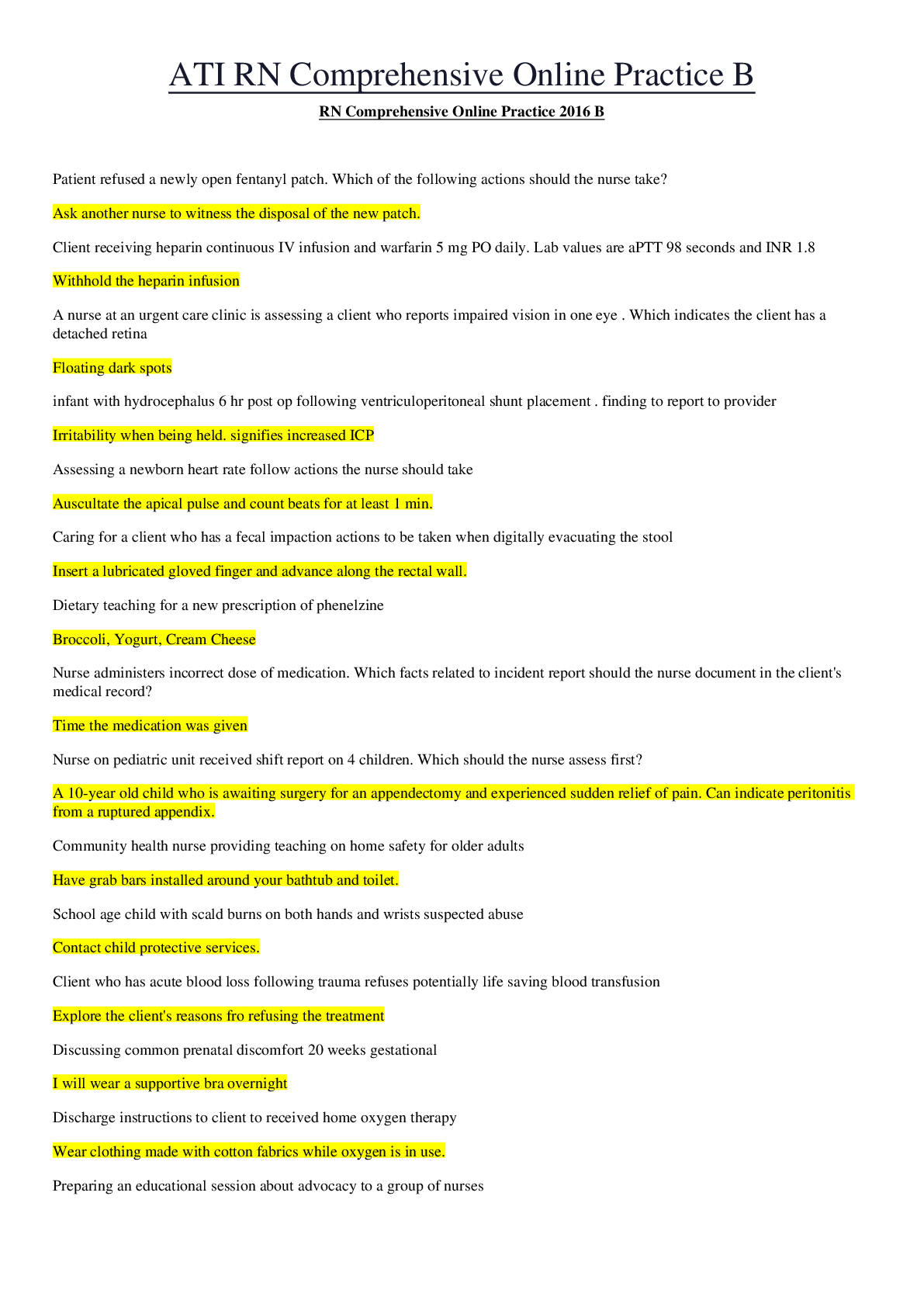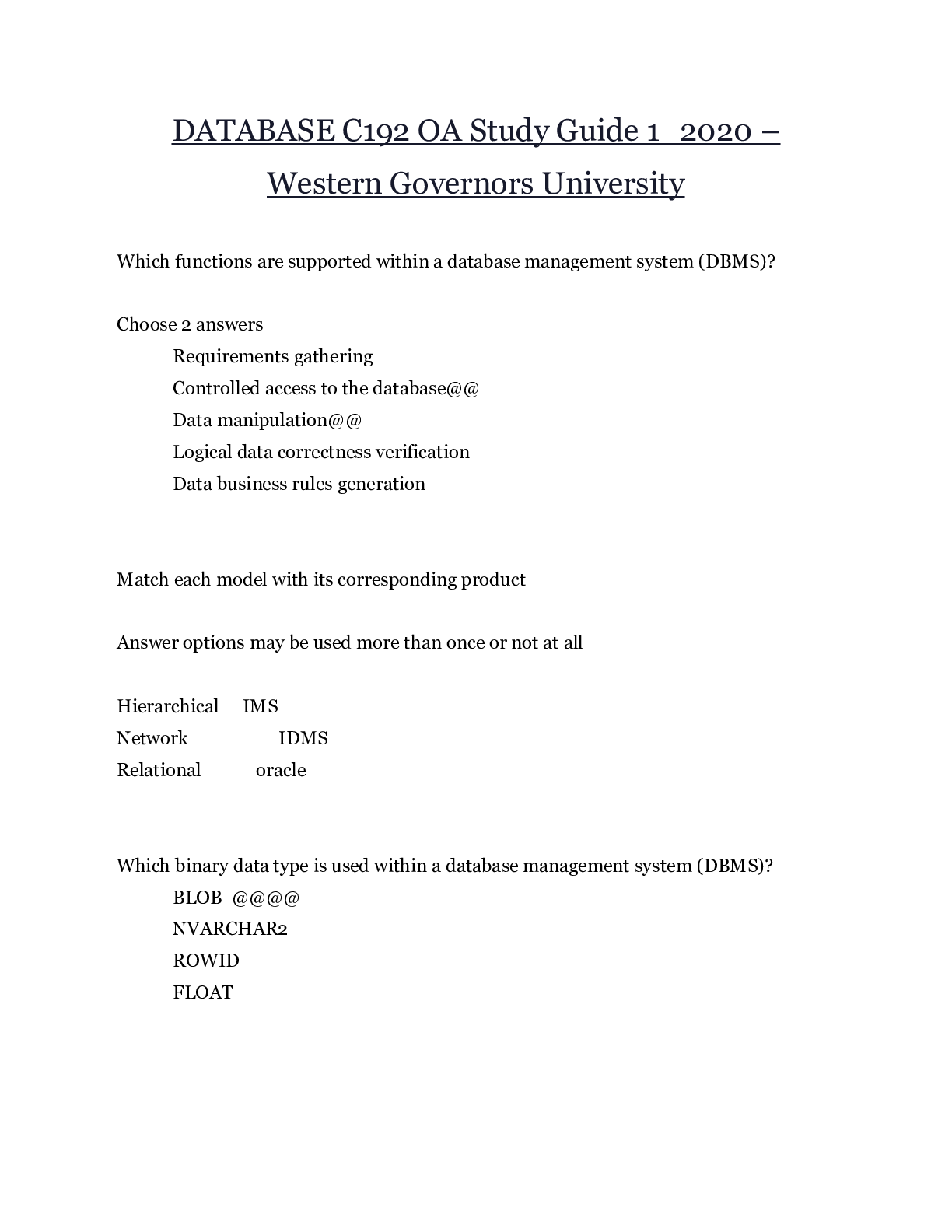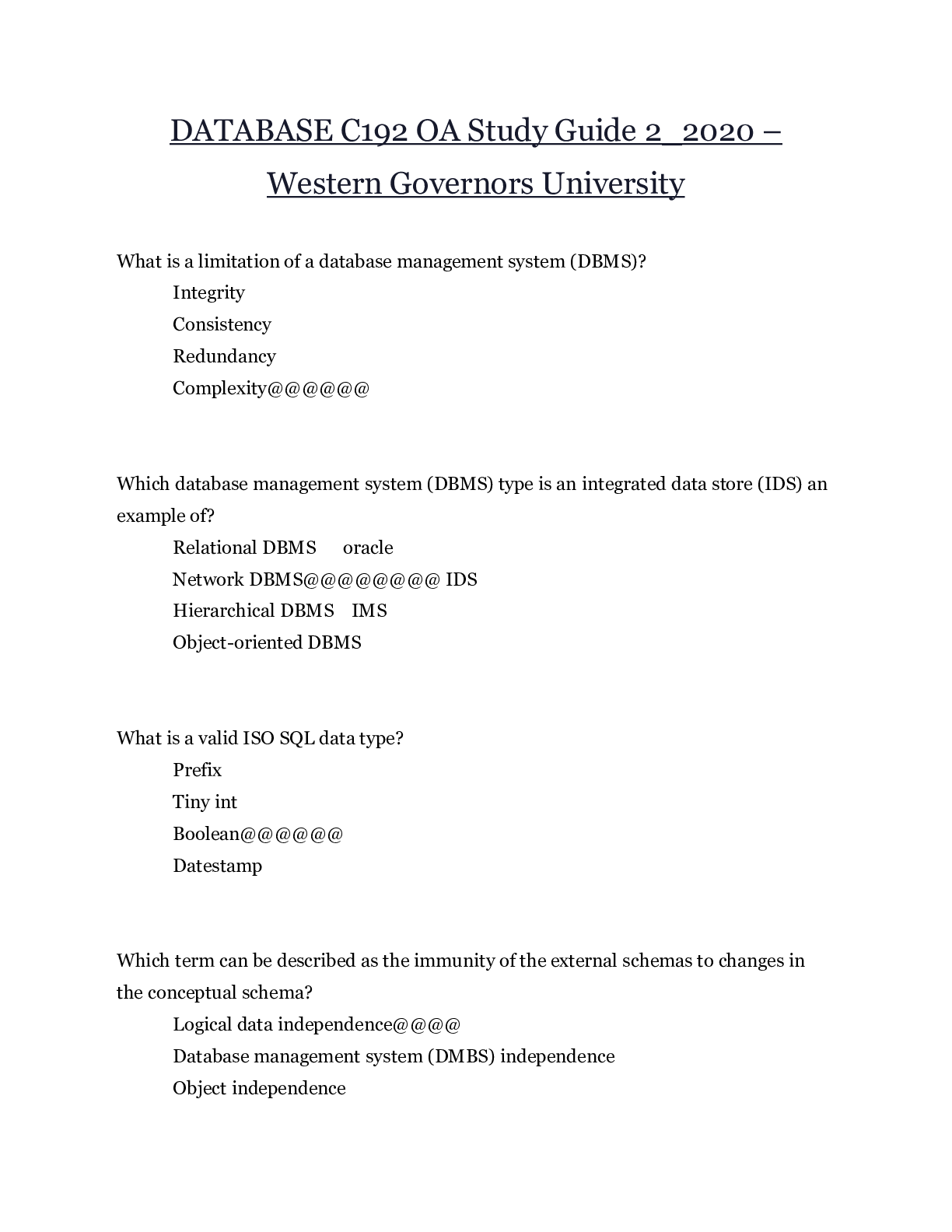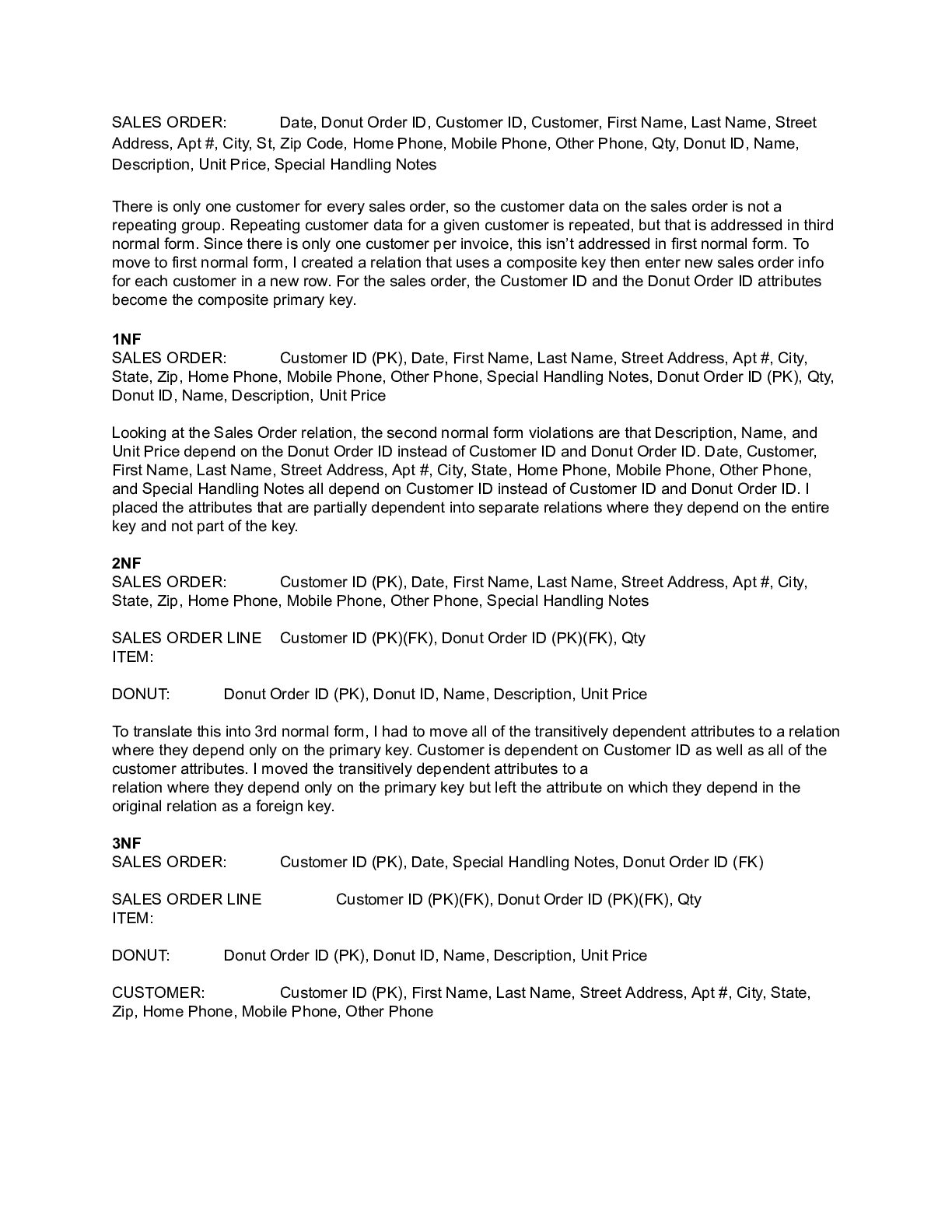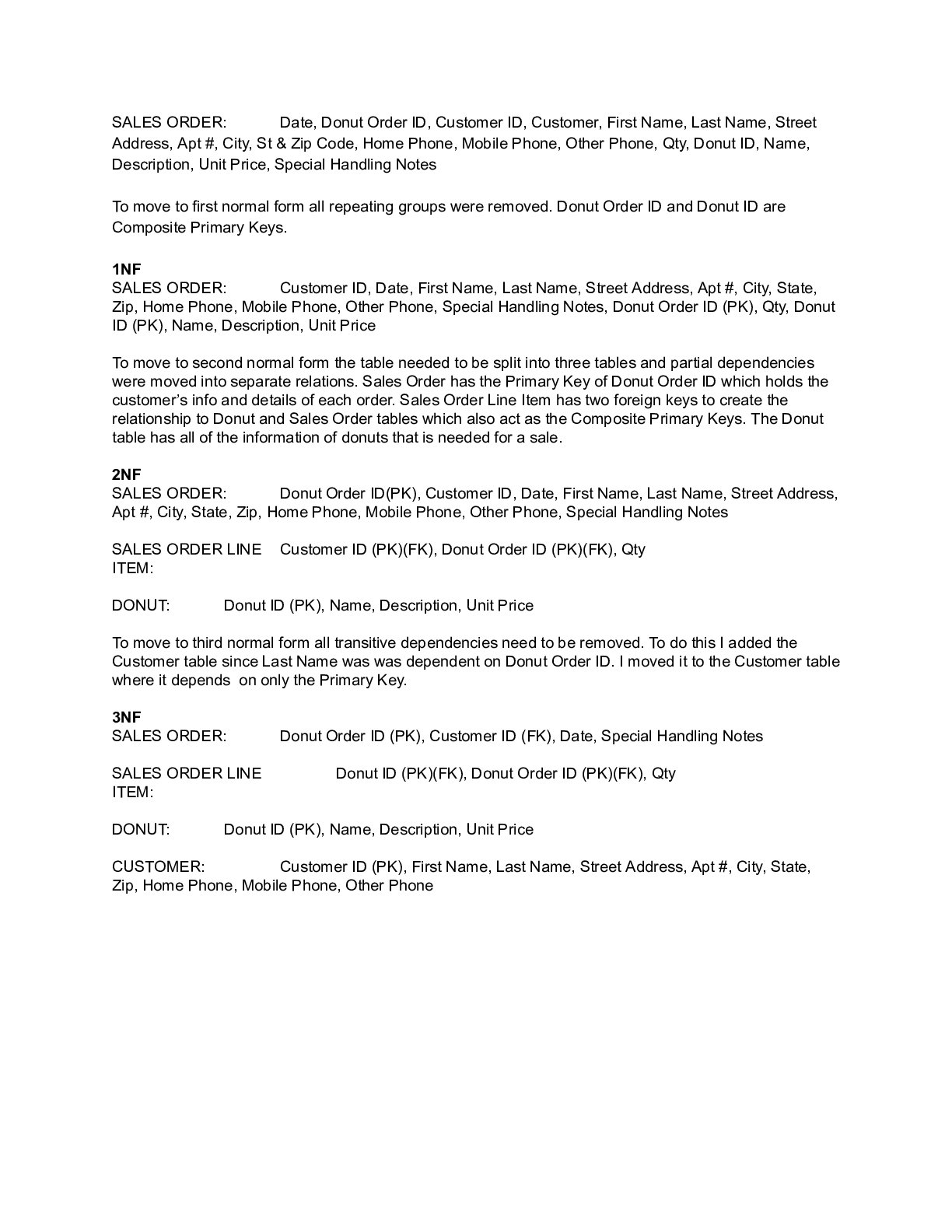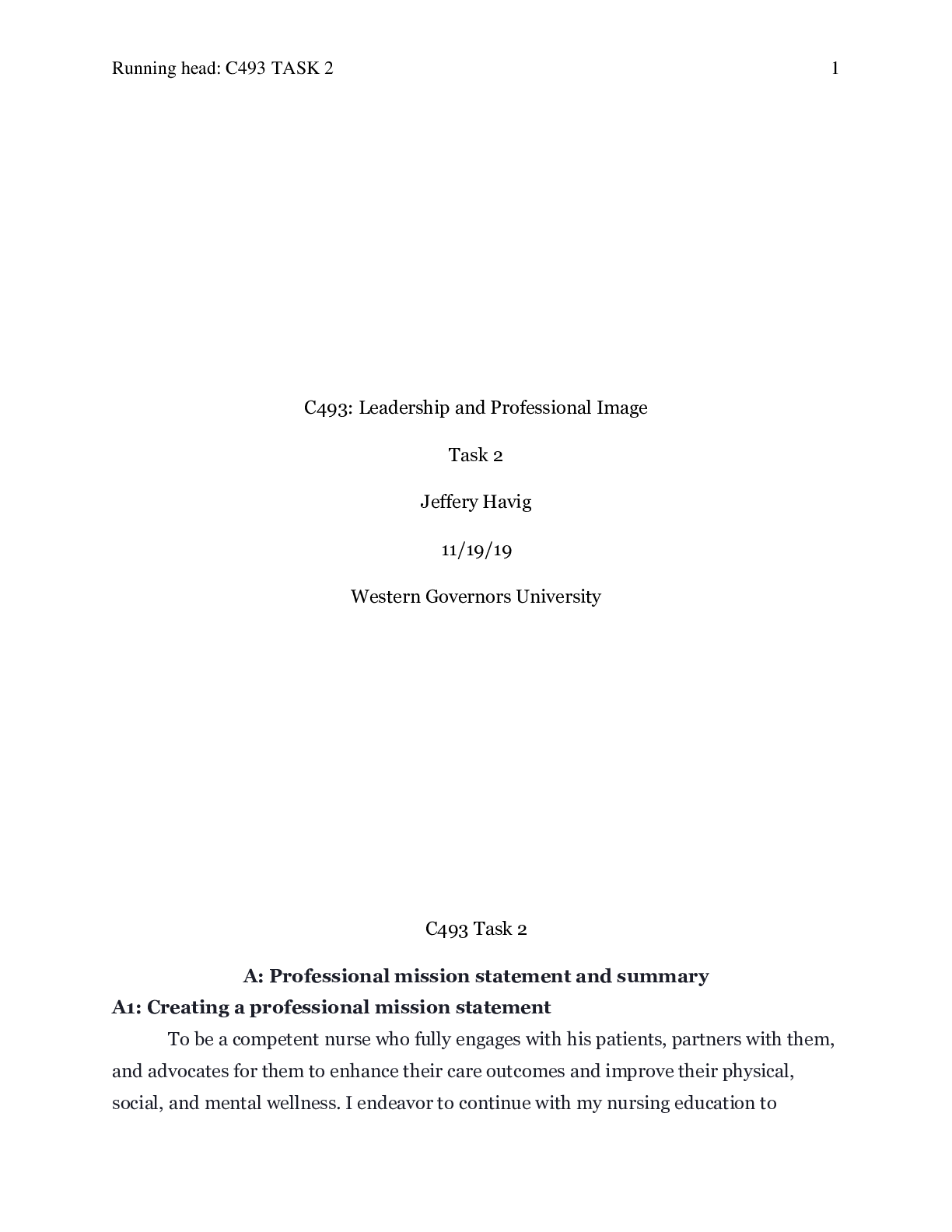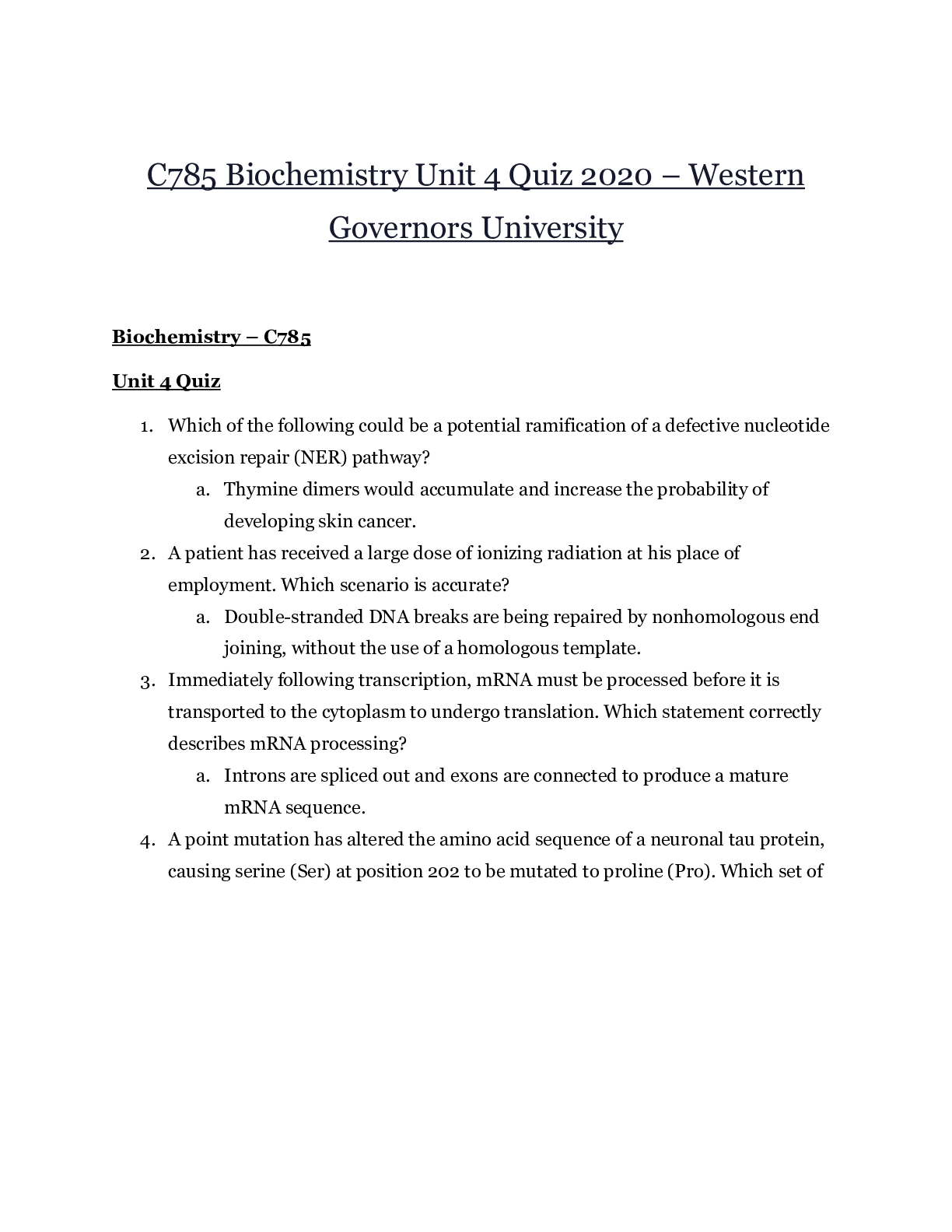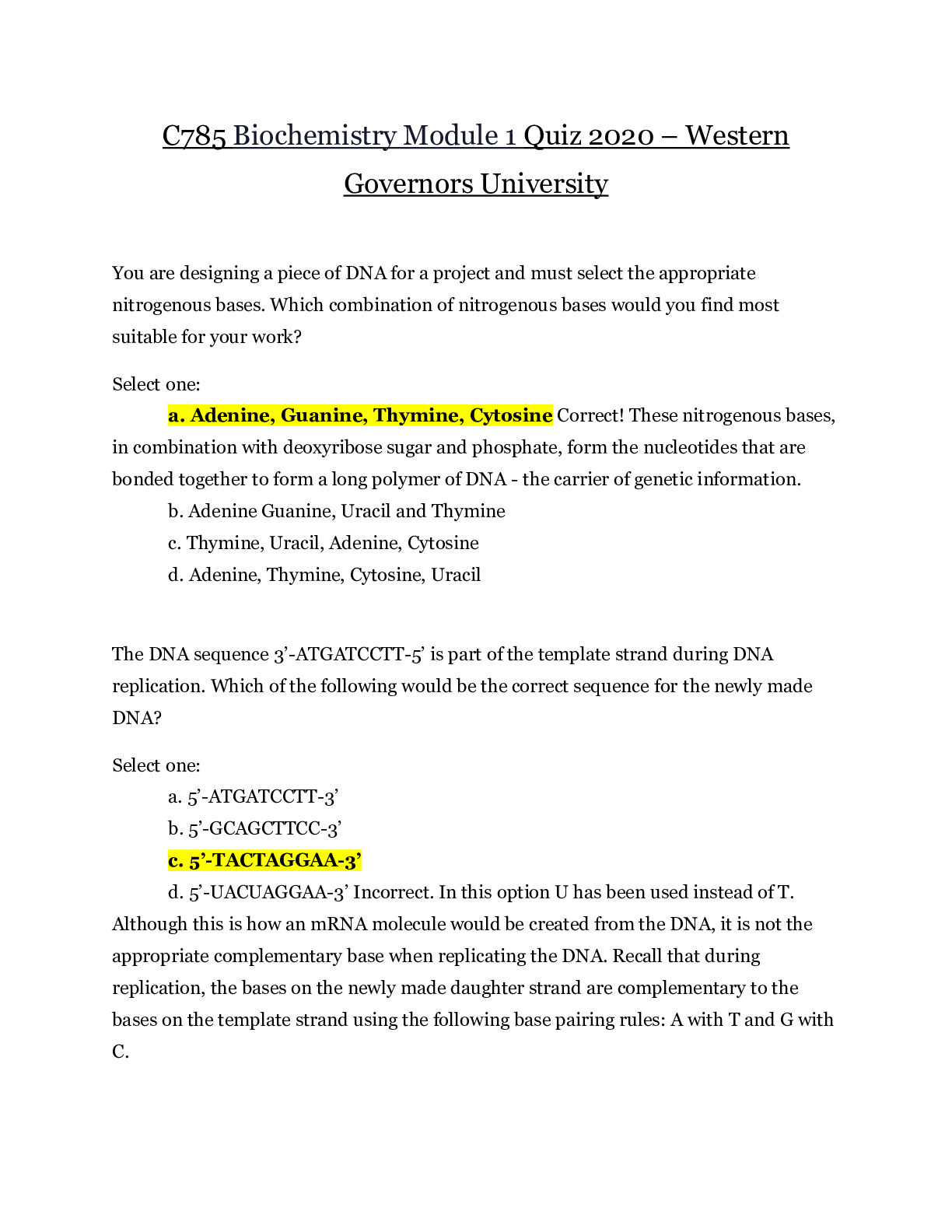BioChemistry > EXAM > Biochemistry C785 Module 3 Myoglobin and Hemoglobin Quiz 2020 – Western Governors University | Mod (All)
Biochemistry C785 Module 3 Myoglobin and Hemoglobin Quiz 2020 – Western Governors University | Module 3 Myoglobin and Hemoglobin Quiz 2020
Document Content and Description Below
Biochemistry C785 Module 3 Myoglobin and Hemoglobin Quiz 2020 – Western Governors University 25. What level of protein structure does hemoglobin have that is not found in myoglobin? 1. primary ... 2. secondary 3. tertiary 4. quaternary 10. Even though the amino acid sequence between subunits of hemoglobin and myoglobin are not exactly the same, there are other similarities between the two proteins. Which level of protein structure differs when comparing myoglobin to hemoglobin? 1. Primary 2. Secondary 3. Tertiary 4. Quaternary 43. As carbon monoxide binds to hemoglobin, the protein subunits change conformation to allow carbon monoxide to bind faster. This process is called __________. 1. non-competitive inhibition 2. allosteric binding 3. positive cooperativity 4. competitive inhibition 1. Which of the following accurately describes the functions of hemoglobin and myoglobin? 1. Hemoglobin transports oxygen, Myoglobin stores oxygen. 2. Hemoglobin stores oxygen, Myoglobin transports oxygen. 3. Hemoglobin transports CO2 and Myoglobin stores CO2 4. Myoglobin transports CO2 and Hemoglobin stores CO2 7. Hemoglobin and myoglobin proteins bind molecular oxygen. The protein subunit of hemoglobin does not bind directly to the oxygen. Instead, a specific atom binds oxygen. In hemoglobin, which of the following will directly bind oxygen? 1. Histidine 2. Heme 3. Carbon Monoxide 4. Iron 54. Which of the following also describes an "basic" condition? (Choose all that apply.) 1. low pH 2. high pH 3. low H+ 4. high H+ 5. low protons 6. high protons 20. Which one of the following statements about the graph is accurate? 1. The T state of hemoglobin is favored by low pH and induces the release of oxygen 2. The R state is the prevalent form of hemoglobin at low pH 3. The R state is favored by the low pH and induces the binding of oxygen 4. The T state of hemoglobin is favored by high pH and induces the release of oxygen 32. Acidosis occurs as a result of cardiac arrest. Which of the following is the theoretical reason why sodium bicarbonate might be administered to your patient during a cardiac arrest? 1. The bicarbonate acts to decrease pH, which enables hemoglobin to enter the T state and more effectively deliver oxygen to the tissues. 2. The bicarbonate acts to decrease pH, which enables hemoglobin to enter the lung and resume binding to oxygen. 3. The bicarbonate acts to increase pH, which may allow hemoglobin to transport oxygen more efficiently. 4. The bicarbonate acts to increase pH, prompting hemoglobin to shift to the R state and pick up CO2 that has accumulated during the cardiac arrest. 17. Myoglobin stores oxygen, whereas hemoglobin transports oxygen. Which of the following statements accurately describes the affinity of myoglobin and hemoglobin for oxygen? 1. Hemoglobin and myoglobin both have the same affinity for oxygen. 2. Hemoglobin has a higher affinity for oxygen compared to myoglobin. 3. Myoglobin has exactly one-quarter of the affinity for oxygen because it has only one subunit. 4. Myoglobin has a higher affinity for oxygen compared to hemoglobin. 39. Carbonic anhydrase is an important __________ present in the red blood cells that aids in efficient transportation of carbon dioxide in the form of _________, from tissues to lungs. 1. enzyme, carbon dioxide 2. substrate, bicarbonate ions 3. enzyme, bicarbonate ions 4. chemical, carbon monoxide 35. Oxygen binding alters the structure of an entire hemoglobin tetramer, so the structures of oxyhemoglobin and deoxyhemoglobin are noticeably different. The oxyhemoglobin conformation is specifically referred to as the __________ state, whereas the deoxyhemoglobin conformation is referred to as the __________ state. 1. Oxygenated and Deoxygenated 2. O and D 3. Relaxed and Tense 4. There is no difference between the two states 45. Why is myoglobin incapable of exhibiting cooperativity? 1. Myoglobin has only one subunit and can only bind one molecule of oxygen. 2. Myoglobin binds four molecules of oxygen. 3. Myoglobin delivers oxygen to metabolizing tissues. 4. Myoglobin adopts the R-state when it binds to oxygen. 44. Which of the following is accurate for hemoglobin and myoglobin? 1. Hemoglobin and myoglobin bind oxygen directly on an iron atom located inside of a heme group. 2. Hemoglobin and myoglobin have similar quaternary structures. 3. Hemoglobin and myoglobin bind oxygen in a cooperative manner. 4. Hemoglobin and myoglobin deliver oxygen in response to the Bohr effect. 3. Hemoglobin's function is to transport oxygen from the lungs to the tissues. In the graph below, which line represents hemoglobin's oxygen binding curve? 1. Solid line 2. Dashed line 36. Patients with sickle cell anemia have atypical hemoglobin, which will distort the red blood cells into sickle shape during oxygen delivery. The substitution of a hydrophilic amino acid with a ____________amino acid in hemoglobin subunits results in the polymerization of hemoglobin, leading to the sickling of red blood cells. 1. polar 2. cysteine 3. hydrophilic 4. hydrophobic 6. Patients with carbon monoxide (CO) poisoning may exhibit pink or cherry red skin, mucus membranes and nails. Which statement accurately describes hemoglobin's role in CO poisoning? 1. Hb binds to CO with a lower affinity than oxygen and stabilizes the R-state. 2. Hb binds to CO with a higher affinity than oxygen and stabilizes the T-state. 3. Hb binds to CO with a higher affinity than oxygen and stabilizes the R-state. 4. Hb binds to CO with a lower affinity than oxygen and stabilizes the T-state. 30. Which represents a subunit in the R state with no oxygen bound? 1. A 2. B 3. C 4. D 22. Which of the following favor the oxygenated form of hemoglobin? (select all that apply) 1. planar heme group 2. high CO2 3. Relaxed state 4. high pH 5. high H+ 6. 2,3-BPG 37. When binding hemoglobin or myoglobin, CO binds in place of _________. 1. Histidine 2. Heme 3. Iron 4. Oxygen 19. Based on the graph (shown below), 50% of Hemoglobin is saturated with oxygen at approximately _________ torr and ______________% of myoglobin is saturated with oxygen at the same concentration. 1. 40, 90% 2. 24, 50% 3. 28, 90% 4. 50, 50% 52. Why is the oxygen binding curve in hemoglobin sigmoidal? Carbon monoxide poisoning 1. The non-planar heme conformation 2. Cooperativity 3. Competitive binding 40. Hemoglobin acts as a buffer and controls the pH of the blood by binding __________. 1. oxygen 2. bicarbonate ion 3. H+ ions 4. carbon dioxide 24. Which of the following components can bind directly to the iron atom in hemoglobin? (select all that apply) 1. heme 2. Oxygen 3. CO 4. CO2 16. Which of the following is associated with cooperativity? 1. The increased affinity for oxygen that myoglobin has when oxygen concentration is low 2. The ability of hemoglobin to supply the RBC with oxygen for ATP production 3. The exchange of oxygen that happens in the placenta between maternal and fetal blood 4. Hemoglobin structural changes that increase its affinity for oxygen 46. Which of the following statements accurately associates the H+ ion concentration and carbon dioxide concentration with hemoglobin's affinity for oxygen? 1. When carbon dioxide levels are high and the H+ concentration is low, hemoglobin prefers to release to oxygen. 2. When carbon dioxide levels are high and the H+ concentration is high, hemoglobin prefers to bind to oxygen. 3. When carbon dioxide levels are low and the H+ concentration is low, hemoglobin prefers to release oxygen. 4. When carbon dioxide levels are low and the H+ concentration is low, hemoglobin prefers to bind to oxygen. 48. What is the oxygen concentration where hemoglobin will be fully saturated? 1. 20-40 torr 2. 40-60 torr 3. 60-80 torr 4. 80-100 torr 50. What is the number of oxygen molecules that must bind in order for hemoglobin to shift to the R–state (relaxed state)? 1. 0 2. 1 3. 2 4. 3 5. 4 12. The structure of fetal hemoglobin allows it to have a higher affinity for oxygen when compared to maternal hemoglobin. Which of the following accurately describes fetal hemoglobin? 1. binds oxygen tightly at lower oxygen concentrations 2. identcal polypeptide chains as adult hemoglobin 3. is never in the R-state 4. exhibits an oxygen binding curve that is the same shape as myoglobin oxygen binding curve. 29. Why is more oxygen unloaded from hemoglobin in an actively metabolizing tissue than in a resting tissue, even at the same PO2? 1. At the lower pH of an actively metabolizing tissue, hemoglobin has a lower affinity for oxygen. 2. Hemoglobin binds four oxygen molecules due to a shape change caused by the lower pH of active tissues. 3. More oxygen is bound to myoglobin at lower oxygen concentrations. 4. More carbon dioxide is drawn out of tissue cells as it is converted to biocarbonate in red blood cells. 23. Which of the following does not bind directly to hemoglobin? 1. O2 2. CO 3. CO2 4. H+ 5. 2,3 BPG 28. Which of the following stabalizes the T state of hemoglobin? (Choose all that apply.) 1. Low pH 2. High pH 3. 2, 3 – BPG 4. Carbon monoxide 47. Identify the image that corresponds to the T (tense) state. Option 1 Option 2 27. Hemoglobin's structure allows it to bind oxygen in the lungs. Which of the following accurately describe hemoglobin's structure in the lungs? (Choose all that apply) 1. Hemoglobin is in the R state. 2. The heme group is planar. 3. Hemoglobin's subunits are further apart from one another than they are in the deoxygenated state. 4. Hemoglobin's subunits are closer together than they are in the deoxygenated state. 18. Hemoglobin transports oxygen and myoglobin stores oxygen. They exhibit different oxygen binding curves when plotted on a graph with total partial pressure of the oxygen (x-axis) plotted against the percent saturation of hemoglobin (y-axis). What is the shape of the oxygen binding curves for hemoglobin and myoglobin? 1. Hemoglobin has a sigmoidal curve, whereas myoglobin has a hyperbolic curve 2. Myoglobin has a sigmoidal curve, whereas hemoglobin has a hyperbolic curve 3. Both have a sigmoidal curve 4. Both have a hyperbolic curve 8. Carbon monoxide is poisonous because the ability of carbon monoxide to bind to hemoglobin is ___________ than the ability of oxygen to bind to hemoglobin. 1. 20 times lower 2. 200 times lower 3. 200 times higher 4. 20 times higher 9. 2,3 BPG stabilizes the _____ state(s) of hemoglobin. 1. T 2. R and T 3. R 4. None of the options are correct 42. Carbon monoxide outcompetes oxygen for attachment to the __________ group of hemoglobin where it is permanently, covalently attached. 1. heme 2. ligand 3. sulfide 4. histidine 34. Addition of ______________________alters the shape of the iron–heme complex, and therefore its absorption of light as indicated by its color change from dark purple (the color of hemoglobin in venous blood) to brilliant scarlet (the color of hemoglobin in arterial blood). 1. globin subunit 2. iron 3. oxygen 4. porphyrin 13. When the blood pH is low, the heme is in_______________ shape. When the blood pH is high, the heme is in ______________shape. 1. planar, bent (non-planar) 2. bent (non-planar), bent (non-planar) 3. bent (non-planar), planar 14. In which of the following patients is the planar conformation of the heme group in hemoglobin favored? 1. In a girl with diabetic ketoacidosis 2. In a firefighter who is brought to the emergency room after entering a burning building 3. In an older woman with pneumonia and sepsis who has a blood pH of 7.1 4. In the muscle capillaries of a patient who is on a treadmill for a cardiac stress test 2. Which of the following is associated with myoglobin? 1. Cooperativity 2. Four oxygen molecules 3. One heme group 4. Two subunits 5. Which of the following statements accurately describes cooperativity? 1. Myoglobin can bind subsequent molecules of oxygen more easily after the first oxygen molecule binds. 2. Myoglobin and hemoglobin work together to deliver oxygen to the tissues. 3. Hemoglobin can bind subsequent molecules of oxygen more easily after the first oxygen molecule binds. 4. Oxygen and carbon dioxide exchange occurs in the alveoli of the lungs. 49. How many oxygen molecules are bound to hemoglobin when the protein is in the T–state (tense state)? 1. 4 2. 3 3. 2 4. 0 26. Which of the following is associated with carbon monoxide poisoning? (check all that apply) 1. it stabilizes the R state of hemoglobin 2. it stabilizes the T state of hemoglobin 3. it increases hemoglobin's affinity for O2 4. it decreased hemoglobin's affinity for O2 5. it binds to hemoglobin with a higher affinity than O2 4. According to the graph below, which protein has a higher affinity for oxygen at 20 torr? Hemoglobin or Myoglobin? 1. Hemoglobin 2. Myoglobin 31. Which of the following facilitates the transition of hemoglobin from the R state to the T state? 1. a scarcity of 2,3-BPG 2. an increase in the concentration of H+ 3. an increase in CO. 4. a decrease in CO2. 21. The symptoms of sickle cell anemia are primarily because red blood cells are misshaped. Which of the following is associated with the cause of sickle cell anemia? 1. a mutation in the beta hemoglobin gene, which leads to insertion of glutamate into the hydrophobic patches of oxygenated hemoglobin. 2. a mutation in the alpha hemoglobin gene, which leads to insertion of valine into the hydrophobic patches of deoxygenated hemoglobin. 3. a mutation in the alpha hemoglobin gene, which leads to insertion of valine into the hydrophobic patches of oxygenated hemoglobin. 4. a mutation in the beta hemoglobin gene, which leads to insertion of valine into the hydrophobic patches of deoxygenated hemoglobin. 53. Which of the following describes an "Acidic" condition? (Choose all that apply). 1. low pH 2. high pH 3. low H+ 4. high H+ 5. low protons 6. high protons 15. When hemoglobin changes from T to R, it has ________ affinity for oxygen. 1. zero 2. high 3. low 4. none of these are correct 33. Myoglobin and hemoglobin each have different numbers of subunits and this affects their respective oxygen storage and delivery capabilities. How many subunits does myoglobin have versus hemoglobin? 1. One, Four 2. Two, Three 3. One, Two 4. Four, One 41. Structurally, hemoglobin can bind ___ molecules of oxygen, all of which could potentially be replaced by carbon monoxide. 1. 1 2. 3 3. 4 4. 2 11. In the deoxygenated state the Heme is ____________, where as in the oxygenated state, the heme is _____________________. 1. planar, planar 2. planar, bent (non-planar) 3. bent (non-planar), planar 4. bent (non-planar), bent (non-planar) 51. Carbon monoxide binds to the __________ in hemoglobin. The binding of carbon monoxide is ________ than the the binding of oxygen in hemoglobin. 1. iron, stronger 2. phosphate, stronger 3. iron, weaker 4. phosphate, weaker 38. Hemoglobin’s cooperative binding behavior is key to its physiological function. The binding of which of the following molecules influences this behavior? 1. Oxygen 2. Heme 3. None of these 4. Iron [Show More]
Last updated: 2 years ago
Preview 1 out of 16 pages

Buy this document to get the full access instantly
Instant Download Access after purchase
Buy NowInstant download
We Accept:

Reviews( 0 )
$14.00
Can't find what you want? Try our AI powered Search
Document information
Connected school, study & course
About the document
Uploaded On
Nov 23, 2020
Number of pages
16
Written in
Additional information
This document has been written for:
Uploaded
Nov 23, 2020
Downloads
0
Views
129








 – University of the People.png)
